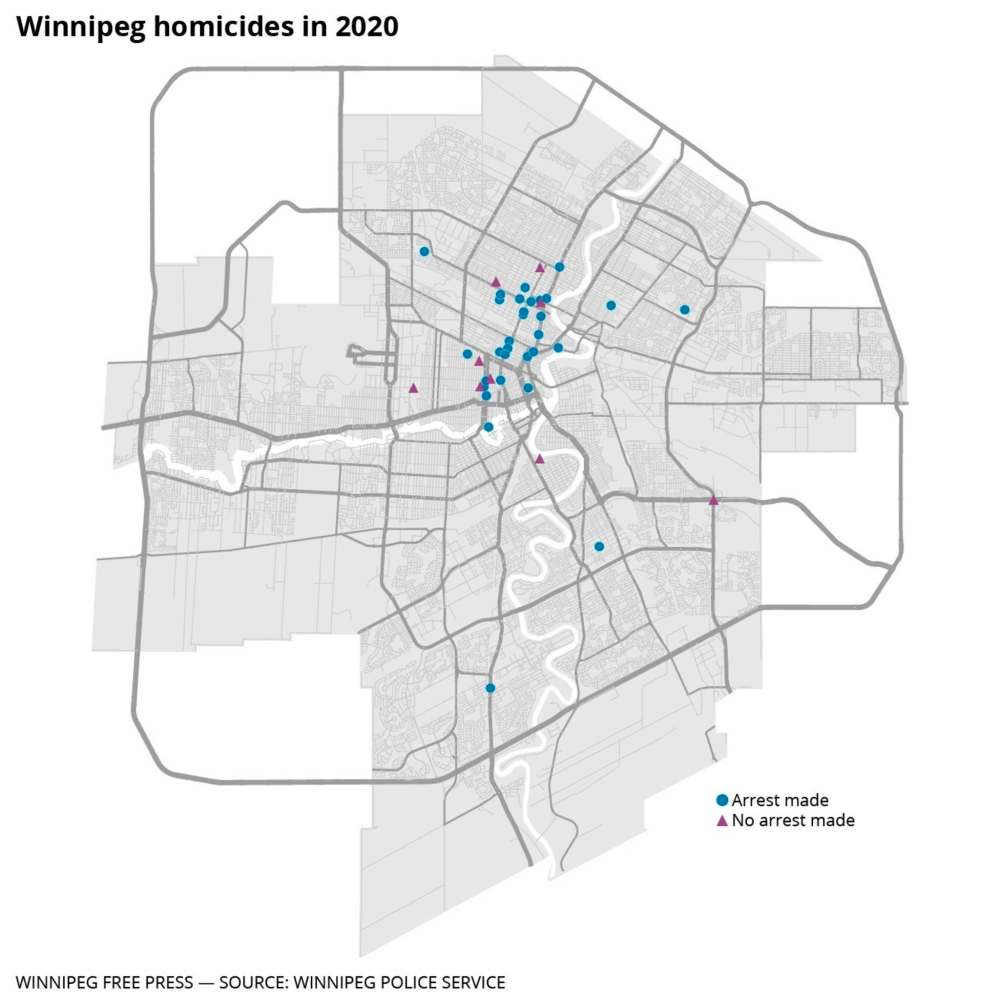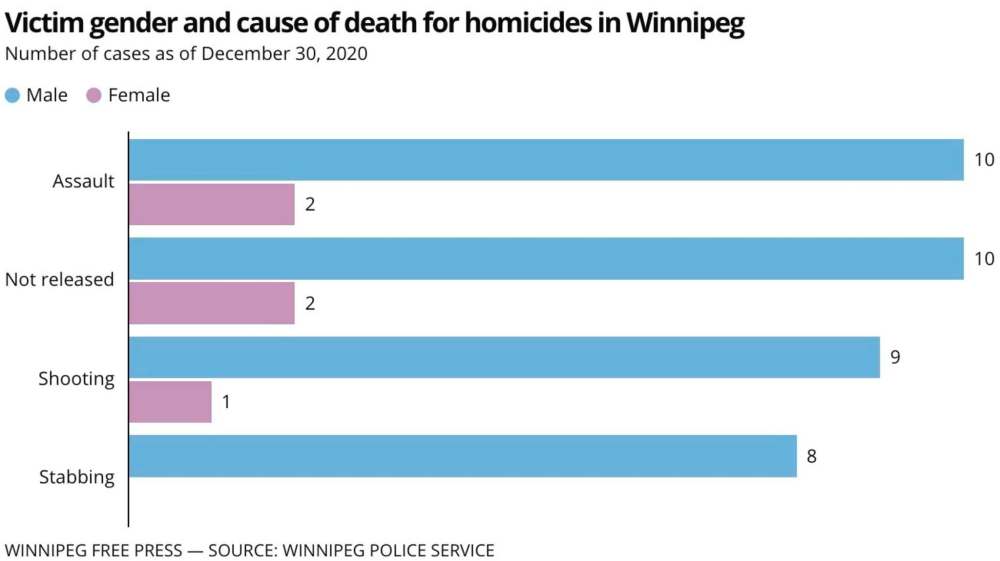Winnipeg’s grim annual milestone City has observed 43 homicides in 2020, one shy of last year's record
Read this article for free:
or
Already have an account? Log in here »
To continue reading, please subscribe:
Monthly Digital Subscription
$0 for the first 4 weeks*
- Enjoy unlimited reading on winnipegfreepress.com
- Read the E-Edition, our digital replica newspaper
- Access News Break, our award-winning app
- Play interactive puzzles
*No charge for 4 weeks then price increases to the regular rate of $19.00 plus GST every four weeks. Offer available to new and qualified returning subscribers only. Cancel any time.
Monthly Digital Subscription
$4.75/week*
- Enjoy unlimited reading on winnipegfreepress.com
- Read the E-Edition, our digital replica newspaper
- Access News Break, our award-winning app
- Play interactive puzzles
*Billed as $19 plus GST every four weeks. Cancel any time.
To continue reading, please subscribe:
Add Free Press access to your Brandon Sun subscription for only an additional
$1 for the first 4 weeks*
*Your next subscription payment will increase by $1.00 and you will be charged $16.99 plus GST for four weeks. After four weeks, your payment will increase to $23.99 plus GST every four weeks.
Read unlimited articles for free today:
or
Already have an account? Log in here »
Hey there, time traveller!
This article was published 30/12/2020 (1808 days ago), so information in it may no longer be current.
It’s been another bloody year in Winnipeg.
After the city logged a record 44 homicides in 2019, it faces another grim death toll in 2020, amid a global pandemic and government-mandated lockdowns.
As of Wednesday morning, there had been 43 slayings in Winnipeg this year.
The first came Jan. 10, when Reagan Danielle Gross, 49, was killed on the 100 block of Hindley Avenue. The cause of death was not released.
Two days later, Yassin Abdu Ahmed, 20, was shot to death on the 100 block of Garry Street.
The last homicide of 2020 — barring a New Year’s Eve incident — came Christmas Eve, when Lloyd William Chubb was slain on the 500 block of Furby Street. Authorities have not released the cause of death.
On Aug. 4, the Winnipeg Police Service reported the late-July death of a three-month-old baby. Within days, the sole suspect in the case, an adult man, was found dead at a home in the Silver Heights neighbourhood. No foul play is suspected in the man’s death.
On Wednesday, a WPS spokesman said the death of the infant had not yet been confirmed as a homicide by medical evidence. Should that change, it would push the city’s count up to 44 — tying its record-setting total from 2019.
Of the cases where the cause of death was released, there were 11 assaults, 10 shootings and eight stabbings. There were 37 men and five women killed, and one case where the gender of the victim was not released.
Five of the victims were under the age of 18; 21 were aged 18 to 34.
The WPS investigated 42 of this year’s confirmed homicide cases. Ten remain open, a spokesman said Wednesday, giving the homicide unit a clearance rate of 76.2 per cent.
In 2019, the WPS investigated all 44 city killings, with a clearance rate of 89.2 per cent. In 2018, the city recorded 22 homicides, all of which were handled by the WPS.
One of Winnipeg’s slayings in 2020 was investigated by the RCMP.
On June 24, the body of Gerhard Reimer-Wiebe, 27, was found on Baker Street in Portage la Prairie. The Mounties’ investigation led to a residence on Alfred Avenue in Winnipeg.
That residence — where police say Reimer-Wiebe was killed — had burned to the ground, although investigators are mum on whether they believe the fire was deliberately set to cover up a crime scene.
RCMP Supt. Michael Koppang called it a “horrendous, vile and senseless” crime.
In July, police arrested two suspects: Kyle Evan Sinkovits, 29, and Jonathan Bradley Narvey, 25. The following month, police arrested two others: Bobby Lynn Hall, 26, and Chelsea O’Hanley, 24.
All four have been charged with first-degree murder, forcible confinement, and indignity to a dead human body. The allegations have not been proven in court.
A spokesman said Manitoba RCMP have investigated 24 homicides in the province this year, although he couldn’t say how many cases remain open.
A request for comment from the Brandon Police Service about its homicide total was not answered by deadline.
Kevin Wong, an associate professor in the department of sociology at Brandon University, said: “It does not take a criminologist” to note the number of homicides in Winnipeg the past two years are “shockingly high.”
“Again, we have an unusually high number of homicides this year in Winnipeg, just like last year. I hope this is not a new trend that we are looking at,” Wong said in a written statement.
He noted the national trend for Canada has been relatively stable over the years, with about 1.80 homicides per 100,000 people. The rate in Winnipeg, however, nearly doubled in 2019 — to 5.31 from 2.69.
“It is sitting at a similarly high rate in 2020. This certainly is not normal, and should warrant further investigation… As a researcher, I would look into… domestic violence, gangs and drugs (as factors),” Wong said.
Karen Wiebe, executive director of the Manitoba Organization for Victim Assistance, said the fact Winnipeg has recorded 87 slayings over the past two years should set off alarm bells. That level of violence, she said, speaks to an unhealthy city.
“It’s a very sad indication of what’s going on here — the level of violence and the level of anger. What is causing this kind of violence to be occurring? What is it that is driving it?” Wiebe said.
While an act of violence may be singular, a killing has repercussions that ripple out into the wider community and continue to echo through the years, she said. T.J. Wiebe, her 20-year-old son, was murdered Jan. 5, 2003, and his body left in a snow-filled ditch.
Eighteen years later, Karen Wiebe said she still can’t return to place where his body was found that winter, nor watch TV shows or movies that show a frozen body.
“The family and friends of a murder victim never get over it. The word ‘closure’ should be stricken from the dictionary. There is no such thing as closure… It’s about learning to live with what happened and learning to live with the visions of how that person died,” Wiebe said.
“I know people, for example, who have had somebody murdered in a parking garage. They can’t go into parking garages anymore. I know people who have had somebody murdered in this city. They’re from the country; they can’t come into this city anymore.”
That’s the reality 43 more families face after another year in Winnipeg.
ryan.thorpe@freepress.mb.ca
Twitter: @rk_thorpe

Ryan Thorpe likes the pace of daily news, the feeling of a broadsheet in his hands and the stress of never-ending deadlines hanging over his head.
Our newsroom depends on a growing audience of readers to power our journalism. If you are not a paid reader, please consider becoming a subscriber.
Our newsroom depends on its audience of readers to power our journalism. Thank you for your support.










.jpg?h=215)
